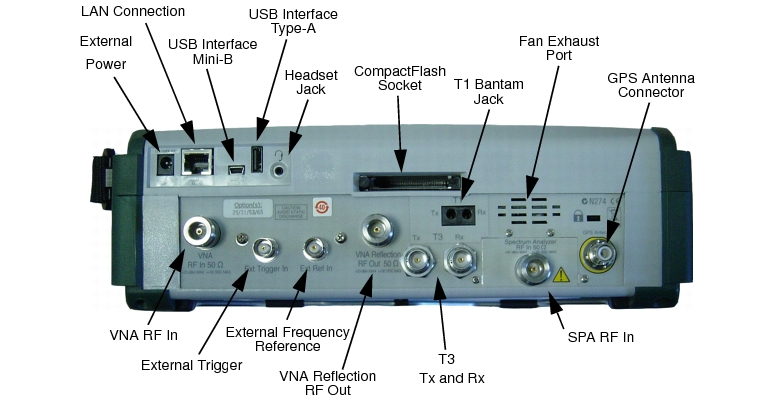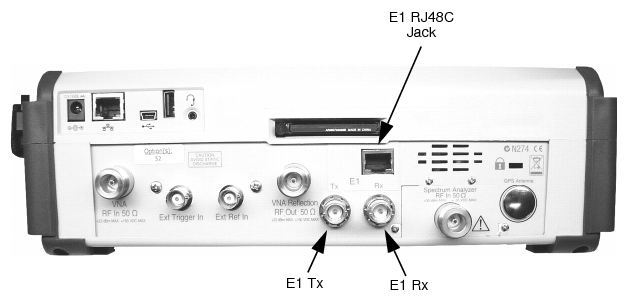The test panel connectors are shown in Figure: “Test Panel Connectors, including T1 and T3” and Figure: “Test Panel Connectors, Including E1” and are described in the following text.
The external power connector is used to power the unit and for battery charging. Input is 12 VDC to 15 VDC at up to 5.0 A. A green flashing indicator light near the power switch shows that the instrument battery is being charged by the external charging unit. The indicator is steadily illuminated when the battery is fully charged.
|
When using the AC‑DC Adapter, always use a three‑wire power cable that is connected to a three‑wire power line outlet. If power is supplied without grounding the equipment in this manner, then the user is at risk of receiving a severe or fatal electric shock.
|
LAN Connection
The RJ‑45 connector is used to connect the BTS Master to a local area network. Integrated into this connector are two LEDs. The amber LED shows the presence of a 10 Mbit/s LAN connection when on, and a 100 Mbit/s LAN connection when off. The green LED flashes to show that LAN traffic is present. For additional information about the LAN connection, Ethernet connection, and DHCP, refer to “LAN and DHCP”.
USB Interface – Type Mini‑B
The USB 2.0 interface can be used to connect the MT8222A BTS Master directly to a PC. The first time the MT8222A is connected to a PC, the normal USB device detection by the computer operating system will take place. The CD‑ROM that shipped with the instrument contains a driver for Windows XP that is installed when Master Software Tools is installed. Drivers are not available for earlier versions of the Windows operating system. During the driver installation process, place the CD‑ROM in the computer drive and specify that the installation wizard should search the CD‑ROM for the driver.
|
For proper detection, Master Software Tools should be installed on the PC prior to connecting the BTS Master to the USB port.
|
USB Interface – Type A
The MT8222A BTS Master can also be a USB Host and allow various USB Flash Memory devices to be connected to the instrument for storing measurements, setups, and files.
Headset Jack
The headset jack provides audio output from the built‑in AM/FM/SSB demodulator for testing and troubleshooting wireless communication systems. The jack accepts a 2.5 mm 3‑wire miniature phone plug such as those commonly used with cellular telephones.
Ext Trigger In
A TTL signal that is applied to the External Trigger female BNC input connector causes a single sweep to occur. In the Spectrum Analyzer mode, it is used in zero span, and triggering occurs on the rising edge of the signal. After the sweep is complete, the resultant trace is displayed until the next trigger signal arrives. This port is also used for External Clock Recovery in T1/T3/E1 operations (described in the Backhaul Measurement Guide). Refer to “Measurement Guides” for reference to the Backhaul Measurement Guide, which can be found on the documentation disc and the Anritsu web site.
RF detector connector for Power Monitor measurements (Option 5). Refer to the Technical Data Sheet for available RF Detectors.
50 Ω Type-N female connector.
RF output, 50 Ω impedance, for reflection measurements. Maximum input is +23 dBm at ±50 Vdc.
50 Ω Type-N female connector.
|
The GPS antenna connection on the BTS Master is fitted with a reverse BNC connector to help prevent damage to the GPS circuitry. There is a DC voltage present on this connector. Do not connect anything other than the Anritsu GPS antenna (part number 2000-1410) to this port.
|
Accepts a 256 MB CompactFlash Memory Module, Anritsu Part Number 3-2000-1500 or other commercially available equivalent. The contents of the internal memory can be copied to and from a removable CompactFlash card. The flash card can be up to 512 MB.


